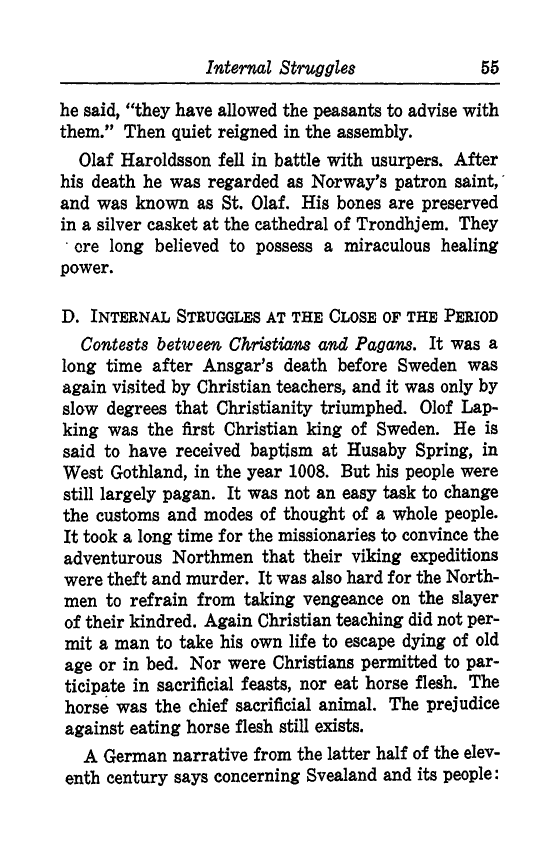
Full resolution (TIFF) - On this page / på denna sida - III. Period of the Vikings and Introduction of Christianity - C. Legendary Tales - D. Internal Struggles at the Close of the Period

<< prev. page << föreg. sida << >> nästa sida >> next page >>
Below is the raw OCR text
from the above scanned image.
Do you see an error? Proofread the page now!
Här nedan syns maskintolkade texten från faksimilbilden ovan.
Ser du något fel? Korrekturläs sidan nu!
This page has never been proofread. / Denna sida har aldrig korrekturlästs.
Internal Struggles 55
he said, "they have allowed the peasants to advise with
them." Then quiet reigned in the assembly.
Olaf Haroldsson fell in battle with usurpers. After
his death he was regarded as Norway’s patron saint,
’
and was known as St. Olaf. His bones are preserved
in a silver casket at the cathedral of Trondhjem. They
ore long believed to possess a miraculous healing
power,
D. INTERNAL STRUGGLES AT THE CLOSE OF THE PERIOD
Contests between Christians and Pagans. It was a
long time after Ansgar’s death before Sweden was
again visited by Christian teachers, and it was only by
slow degrees that Christianity triumphed. Olof Lap-
king was the first Christian king of Sweden. He is
said to have received baptism at Husaby Spring, in
West Gothland, in the year 1008. But his people were
still largely pagan. It was not an easy task to change
the customs and modes of thought of a whole people.
It took a long time for the missionaries to convince the
adventurous Northmen that their viking expeditions
were theft and murder. It was also hard for the North-
men to refrain from taking vengeance on the slayer
of their kindred. Again Christian teaching did not per-
mit a man to take his own life to escape dying of old
age or in bed. Nor were Christians permitted to par-
ticipate in sacrificial feasts, nor eat horse flesh. The
horse was the chief sacrificial animal. The prejudice
against eating horse flesh still exists.
A German narrative from the latter half of the elev-
enth century says concerning Svealand and its people :
<< prev. page << föreg. sida << >> nästa sida >> next page >>